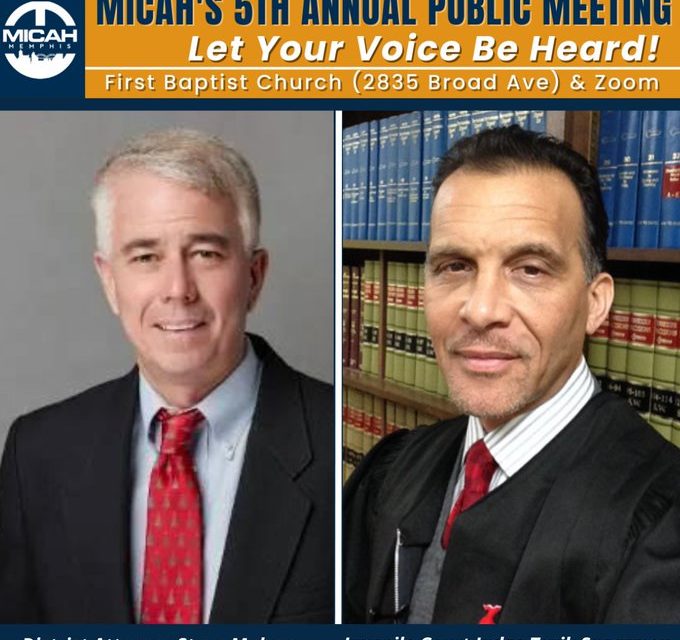Recently elected District Attorney General Steve Mulroy and Juvenile Court Judge Tarik Sugarmon convened a “Youth Crime Working Session” last week and the most exciting part wasn’t what they said but who they invited.
There was of course the Memphis-Shelby Crime Commission whose lack of imagination has dogged efforts to reduce violent crime, but more to the point, there were also presentations from Raphah Institute, Wren Collective, National Institute for Criminal Justice Reform, and Vera Institute of Justice.
In my September 12 blog post, I wrote that doing the same things with the same people and expecting different results was not only the definition of insanity, but it diverts attention from the dramatic action that is needed if Memphis is to reduce the crime rate and the accompanying angst and fear that grip so much of the community.
“Taking dramatic action is not the usual suspects gathering in the usual meeting rooms where groupthink produces variations on the usual strategies,” the post said. “As a result, it’s time for Memphis to organize a summit to ask for help and to increase the intellectual capital that can be focused on finding solutions to combat the rising violent crime rate.”
Sept. 12, 2022 Blog Post: Turning Anger Into Action:
The Memphis Summit on Violent Crime
In a city accustomed to insular discussions, the involvement by Mr. Mulroy and Mr. Sugarmon of some of the country’s most respected criminal justice reform experts. They’re exactly the kinds of organizations that have been regularly dismissed in conversations about reforming criminal justice, reducing crime, and decreasing juvenile recidivism.
As leaders in this sector, these organizations develop research, analysis, and data-based recommendations that could prove relevant for Memphis. Best of all, they are provocative and should stimulate a citywide conversation about a shared agenda for the future.
There are other national organizations being contacted by Mr. Mulroy and Mr. Sugarmon that are on the cutting edge of innovation and new thinking. Equally important, the circle is being widened to include grassroots and nonprofit groups that have been routinely frozen out of discussions.
In addition, here’s hoping that university professors in criminology and criminal justice but also colleagues in other departments with other relevant expertise and ideas can also be engaged. They too aren’t usually included in these kinds of conversations.
Two years ago, when City Hall appointed a committee charged with reimagining MPD (it ultimately failed its mandate), I recommended that its members should ask David Eichenthal for the intellectual capital, and independent thinking, they needed.
It didn’t happen, but now, Mr. Mulroy has asked for his expert advice. Mr. Eichenthal is deeply familiar with City of Memphis as the lead PFM consultant for the Memphis Plan: A Strategic and Management Plan for the City of Memphis, FY 2014-FY 2018. Besides his in-depth knowledge of city government, he is founding member of PFM’s Center for Justice and Safety Finance and its work to address systemic racism through specific actions.
Sept. 10, 2020, blog post: Can The Police Committee Be A Force
For Change, Not More Of The Same?
All of this is more than encouraging. In truth, it has the potential to launch a new era for crime prevention and criminal justice reform for our community.
The implications are significantly consequential. There is of course the impact on the crime rate itself but there is also the financial burden on taxpayers.
Spending for criminal justice – from police to prisons – by City of Memphis and Shelby County Government is $625 million every year – or roughly $6 billion in the past decade.
If the new thinking by Mr. Mulroy and Mr. Sugarmon could reduce the annual costs of criminal justice by only 5%, it could free up $31 million to be spent on productive uses in the community…or it could go a long way to fund a serious program of prevention and intervention.
As Mr. Mulroy pointed out last week, in quoting former county sheriff and mayor Mark Luttrell, crimefighting is a three-legged stool – suppression, prevention, and intervention. As Mr. Luttrell has pointed out, we have concentrated on one leg – suppression (arrests) – when the other two have the potential to have impact on the crime rate.
Trend Lines Headed The Wrong Way
So far, strategies for combatting violent crime have largely failed despite political leadership and Crime Commission:
Major Violent Crime Rate (incidents per 100,000 population – First Quarter 2022):
462.7 – 2006 – Mayor Willie W. Herenton in Office
362.5 – 2011 – Mayor A C Wharton elected mayor; Amy Weirich elected attorney general
434.7 – 2016 – Jim Strickland elected mayor; Bill Gibbons becomes head of Crime Commission
539.8 – 2021
506.1 – 2022
It’s no secret that it will take time to turn things around and the biggest challenge is likely to be finding a public with the patience that’s needed to measure the impact of new strategies.
It’s the same challenge faced in cities across the U.S. and which has inspired a burst of activity by mayors to make their cities safer. There may be some lessons there as well.
The mayor of Austin increased funding for violence intervention programs, Baltimore’s mayor has piloted a Group Violence Reduction Strategy, Tampa’s mayor has a new behavioral health co-responder program, Chattanooga’s mayor placed mental health professionals in every community center, Houston’s mayor has a comprehensive violence reduction program, Kansas City co-filed a lawsuit against gun manufacturers, Augusta (GA) releases data on the manufacturers of guns involved in crimes, Newark is reinterpreting public safety through an eosystem, and there are hundreds more programs piloted by mayors.
Meanwhile, here at home, for the first time in years, the elections of Mr. Mulroy and Mr. Sugarmon mean our community is open to new ideas and provocative discussions about ways to reduce crime and along with it, the astronomical costs of criminal justice.
**
Join us at the Smart City Memphis Facebook page for additional postings.



